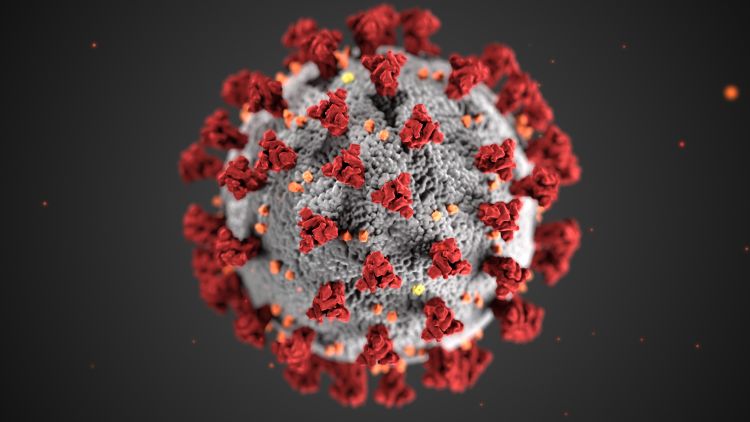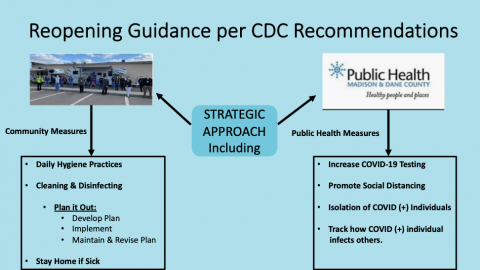DOM COVID-19 Journal Club: Interim guidance by CDC for reopening

Overview
- There should be continual communication with state and local authorities to determine current mitigation levels in community.
- There are recommended steps for each phase of the process:
- Phase 1: for states and regions that satisfy the gating criteria
- Phase 2: for states and regions with no evidence of a rebound and that satisfy the gating criteria a second time
- Phase 3: for states and regions with no evidence of a rebound and that satisfy the gating criteria a third time
Gating criteria
- Downward trajectory of influenza-like illness & COVID-like syndrome cases reported within a 14-day period.
- Downward trajectory of documented cases within a 14-day period or downward trajectory of positive test as a percent of total test within a 14-day period (flat or increasing volume of test).
- Hospitals: treat all patients without crisis care or robust testing program in place for at risk healthcare worker, including emerging antibody testing.

Individual daily habits
- Frequent hand washing
- Wear cloth face covering/face mask
- Use at least 60% alcohol-based hand sanitizer
- Avoid touching eyes, nose or mouth
- Stay home when sick
- Clean using soap and water and disinfect (EPA-approved products) frequently touched objects and surfaces
Cleaning and disinfecting public spaces, workplaces, businesses, schools and homes
- Routine cleaning with soap and water
- Coronavirus on surfaces naturally die within hours to days
- Warmer temperatures reduce time virus survives on surfaces and objects
- Frequent disinfection of surfaces & objects touched by multiple people using an EPA-approved disinfectant against COVID-19
- Alternate disinfectants:
- 1/3 cup bleach: 1 gallon of water
- 70% alcohol solutions
- Alternate disinfectants:
Develop a plan: how to maintain a cleaning and disinfecting strategy
- Type of surfaces in area: frequently touched surfaces and objects like light switches, keyboards, countertops, desks, phones, toilets, faucets, sinks, gas pump handles, touch screen, ATM and door knobs will need to be cleaned and disinfected.
- What can be removed: soft and porous materials like rugs and seating may be removed/stored to reduce challenges with cleaning and disinfecting.
- Otherwise, clean/launder with warmest appropriate temperature of water.
- Outdoor areas: require routine cleaning but no disinfection.
- Proper operation, maintenance and disinfection (chlorine/bromine) of pools, hot tubs or spas should kill COVID virus.
- Area unopened > 7 days should have routine cleaning to reopen.
Implement plan
Maintain and revise plan
- Frequently used items should be cleaned at least daily.
- Shopping carts and point of sale keypads should be cleaned and disinfected before each use.
- Make sure appropriate supply of gloves and appropriate PPE for disinfection available based on product label.
- Practices that reduce potential for exposure:
- Reduce use of porous material for seating;
- Leave some doors open if possible;
- Open windows to improve ventilation;
- Remove objects in common areas like coffee creamer containers.
Guidance for child care programs
- Phase 1: Restrict to children of essential workers in areas needing significant mitigation.
- Phase 2: Expand to all children with enhanced social distancing measures.
- Phase 3: Remain open for all children with social distancing measures.
Guidance for schools and day camps
For communities that remain in low transmission or have entered Phase 2 or 3
- Phase 1: Schools that are currently closed remain closed with e-learning/distance learning opportunities. Camps restricted to children of essential workers and for children in local geographical area.
- Phase 2: Remain open with enhanced social distancing measures and for children who live in local geographical area.
- Phase 3: Remain open with distancing measures…restrict attendance to those from limited transmission areas (other Phase 3 areas).
Guidance for employers with vulnerable workers
Those ages >65 or individuals with underlying medical conditions like chronic lung disease, moderate-severe asthma, hypertension, severe heart conditions, weakened immune system, severe obesity, diabetes, liver disease and chronic kidney disease that requires dialysis.
- Phase 1: Reopen only if business can ensure strict social distancing, proper cleaning and disinfecting requirements and protection of workers and customers; vulnerable workers are recommended to shelter in place.
- Phase 2: Reopen only if business can ensure moderate social distancing, proper cleaning and disinfecting requirements and protection of workers and customers; vulnerable workers recommended to shelter in place.
- Phase 3: Reopen only if business can ensure limited social distancing, proper cleaning and disinfecting requirements and protection of their workers and customers.
Guidance for communities of faith
Gatherings present a special risk for increasing spread of COVID-19 during this public health emergency. These are suggestions offered by CDC.
- Phase 1: Limit gatherings to those that can be held virtually (remote viewing) for vulnerable populations and consider video streaming or drive-in options for service. Limit size of in person gatherings in accordance with guidance and directives of state & local authorities and maintain social distancing.
- Phase 2: Consider continuing virtual gatherings for vulnerable populations and video streaming/drive-in options for services. Limit size of in person gatherings (same as Phase 1).
- Phase 3: Limit gatherings to those that can maintain social distancing and consider video streaming/drive-in options for vulnerable populations.
Safety actions
- Promote daily hygiene practices.
- Intensify cleaning, disinfection and ventilation.
***Children’s books/other paper-based materials are not considered high risk for transmission and don’t need additional cleaning/disinfection.
- Ensure social distancing (space classroom seating and bedding, serve meals in classroom, restrict nonessential visitors, limit services to drive-throughs, curbside takeout/delivery options for employers, video streaming/drive-in options for faith-based communities).
- Limit attendance if social distancing is challenging; especially for funerals, weddings, religious education classes.
- Limit sharing (toys, electronic devices, church bulletins, bibles, hymnals, avoid mixing of classroom groups and instructor, children’s belongings, classroom supplies, provide pre-packaged boxes or bags of food and avoid sharing of food/utensils).
Monitoring and preparing
- Check for signs and symptoms (not suggested for employers with vulnerable workers). Reduce vulnerable workers’ exposure to COVID-19 by encouraging telework options or duties that minimize contact with customers and other employees.
- For school programs:
- Routine daily health checks on arrival to schools (temperature screening of staff and children).
- Daily health check screenings for children in accordance with any applicable privacy laws or regulations. Confidentiality should be maintained.
- Parents/guardians can check child’s temperature at home/school arrival.
- Parent/guardian to confirm that child doesn’t have fever, SOB, or cough.
- Check child for symptoms of illness (flushed cheeks, rapid breathing or difficulty breathing w/o activity, fatigue or extreme fussiness).
- PPE not required if able to maintain a distance of 6 feet from child.
- Plan for when a staff member, student or congregant becomes sick.
- Individual should stay home if sick
- Have a designated individual to track absenteeism to identify trends in employee/child absences due to illness. Have a roster of trained back up staff to maintain sufficient staffing levels.
- Have a designated individual to respond to COVID concerns.
Closing
In the event a person diagnosed with COVID-19 is determined to have been in the building and poses a risk to the community, programs may consider closing for a few days for cleaning and disinfection.
- Close off areas used by any sick person and don’t use until the area has been cleaned. Ideally, wait 24 hours before cleaning or disinfecting to reduce risk to individuals cleaning area.
- Sick individuals should not return until they have met CDC criteria to discontinue home isolation.
- Individuals exposed to COVID+ individual should stay home and monitor for symptoms while following CDC's guidance should symptoms develop.
Reference
- Reopening Guidance for Cleaning and Disinfecting Public Spaces, Workplaces, Businesses, Schools, and Homes. Centers for Disease Control and Prevention. Accessed May 12, 2020.
The Department of Medicine COVID-19 Journal Club is dedicated to understand and applying data on COVID-19 to inform prevention and management efforts for healthcare workers and patients
This viewpoint by Shenikqua Bouges, MD, advanced geriatric fellow, Geriatrics and Gerontology. Reviewed by Nasia Safdar, MD, PhD, professor, Infectious Disease, vice chair for research, Department of Medicine.
Banner image: Centers for Disease Control and Prevention image library